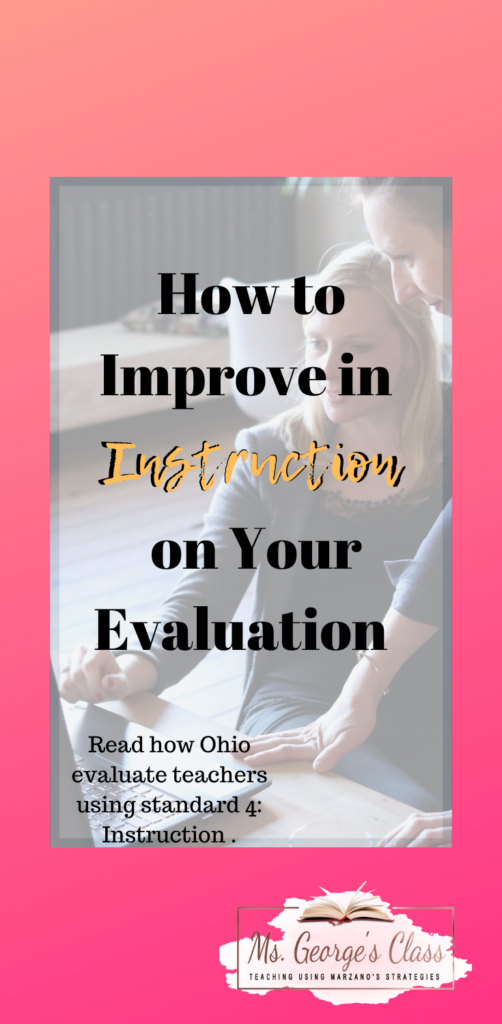This is a 7-part series. You are reading Standard 4 of the 7-part series.

While studying to be a teacher, you spent many hours learning how to structure a lesson. Your class project was to create one lesson plan with detailed explanations. Now you are a teacher and lesson plans are due weekly. According to Standards for Ohio Educators, your job is to “plan and deliver effective instruction that advances the learning of individual students” (26). That sounds great until you look at your class’s demographics. You have a mixture of students ranging from below level to advanced. You have a group of boys who are only interested in sports and do not value what you’re teaching. How do you suppose to give effective instruction? You review the books from your education courses and you follow the standard for instruction. Your performance will improve once you can meet each of your student’s learning needs and incorporate a classroom management plan.
Where to Start with the Ohio Teacher Evaluation
In the state of Ohio, educators are evaluated on several teaching criteria. The evaluation rubric has seven areas to evaluate the teacher’s performance or standards. This article will cover instruction in a systematic, analytical manner to help teachers improve their scores on the evaluation. The seven areas of evaluation are: Standard 1 students, Standard 2 content, Standard 3 assessment, Standard 4 instruction, Standard 5 learning environment, Standard 6 collaboration and communication, and Standard 7 professional responsibility and growth. You may find more information about each standard in the book Standards for Ohio Educators. This is a great source to understand each standard and conquer your goal for earning an accomplished teacher score. Since the information is so intensive, purchasing a binder to keep all your documentation is strongly suggested.
First, when analyzing teaching standards, having the rubric available will assist you in understanding the performance assessment. You can click on this link to get the Ohio Department of Education Teacher Performance Evaluation Rubric (this is now a Word Document; click on the link at the bottom of the page). Marzano has included a supplement to the teacher evaluation model that is aligned with the Ohio State Standards. Also, the book Standards for Ohio Educators is where I gathered most of my information. The Ohio Department of Education has included this book on their website; click here to view the book. The rubric is organized differently from the standards. They are organized in this manner:
| The Focus of Teaching and Learning | The Conditions for Teaching and Learning | Teaching as a Profession |
| Standard 1: Students | Standard 5: Learning Environment | Standard 6: Collaboration and Communication |
| Standard 2: Content | Standard 7: Professional Responsibility and Growth | |
| Standard 3: Assessment | ||
| Standard 4: Instruction |
Standard 4: Instruction
According to the Standards for Ohio Educators, Standard 4: Instruction states, “Teachers plan and deliver effective instruction that advances the learning of each individual student” (26). Effective teachers have high expectations for students; they have a deep knowledge of the content area and understand the sequence of the lesson. They understand differentiation instruction and use it to motivate students while providing a challenging and positive learning environment for all students. They use effective questioning to ignite critical thinking skills and provide opportunities for a variety of instruction, even one that includes technology. There are seven elements within Standard 4, and they are:
“4.1 Teachers align their instructional goals and activities with school and district priorities and Ohio’s academic content standards.
4.2 Teachers use information about students’ learning and performance to plan and deliver instruction that will close the achievement gap.
4.3 Teachers communicate clear learning goals and explicitly link learning activities to those defined goals.
4.4 Teachers apply knowledge of how students think and learn to instructional design and delivery.
4.5 Teachers differentiate instruction to support the learning needs of all students, including students identified as gifted, students with disabilities and at-risk students.
4.6 Teachers create and select activities that are designed to help students develop as independent learners and complex problem-solvers.
4.6 Teachers use resources effectively, including technology, to enhance student learning” (26).
The goal for earning accomplished is to write details on your pre-conference form and to provide documentation. Your documentation must show you are proficient and understand the meaning of using assessments within your class. Before your pre-conference, make sure your lesson plans are very descriptive and focused on the learning target.
Academic Standard
Element 4.1includes aligning your instructional goal with the district’s academic standard. Design the lesson with the standard then create the learning target and finally generate the assessment with the learning target being measured. For example, the standard is reading informational text 7.1, “Cite several pieces of textual evidence to support analysis of what the text says explicitly as well as inferences drawn from the text.” The learning target is “The student can cite several pieces of textual evidence to support an analysis of what the text says and inferences it makes.” Assess students through an exit slip that states, “Cite three pieces of textual evidence to support the main point made in the essay.” The learning target should match how you are assessing your students. I gathered standards, learning goals, and questions from the Columbus City Schools website from the learning target of reading informational text 7.1. Along with using the learning targets, “prioritize, sequence, and group concepts and processes to provide continuous, articulated curriculum” (27) within your lesson plan. You can demonstrate this within your lesson plan or provide a KUD chart. KUD stands for what students know, what students understand, and what students will do. You can create a KUD for each lesson and assess the students’ knowledge to gain insight into how well they understand the concept.

Closing the Gap
Element 4.2 explains how you collect data about your students and how you design the lesson for each student’s learning. Use pre-assessment data and information gathered about individual students to incorporate into the lesson. Use experience, talents, and background information about students to help in designing the lesson. Close the gap by providing meaningful lessons that address all the student population. Within your pre-conference, you could state how you designed the lesson to accommodate all learning styles, test scores, and personal interests.
As you progress through the elements, element 4.3 is how the teacher communicates clear learning goals and links them to the learning activities. One suggestion is to post the learning target on the board and state the learning target throughout your lesson. To score higher on the evaluation, empower students to create and define personal goals they reach. With this element, you really have to perform the act of reading the learning target and getting students to take ownership of it.
Differentiate Instruction
“Apply knowledge of how students think and learn to instructional design and delivery,” (28). Element 4.4 is applying the knowledge you gain from pre-assessments, tests, and behaviors and create an instructional design. Document your use of research-based instruction. For example, if you use Marzano’s strategies, document that within your lesson plans and your pre-conference notes. Explain how the lesson uses the students’ prior knowledge to connect to future lessons. Connect all the information you gather to the students’ needs and how you designed the lesson to meet those needs. Include how you evaluate instructional practices to best suit your students.
Element 4.5 discusses differentiating instruction to meet all students, including gifted, at-risk, and students with disabilities. Gather your test scores, demonstrate flexible grouping and differentiated instruction for all your students. Provide documentation of how you “varied options for how students will demonstrate mastery” (29). This can include a rubric, a variety of texts to read, or modified lessons for each group of students. You earn a distinguished rating if you and your students create methods and strategies to accomplish individual goals and provide professional development for colleagues.

Creating and selecting activities that develop students into independent and complex problem-solvers is the focus of element 4.6. Choose learning activities that support the development of students’ abilities and employing purposeful questioning demonstrates your strength in this area. Use Marzano’s Taxonomy Educational Objective to create higher-level questions and place the questions on your lesson plans and in your pre-conference notes. Encourage students to answer the high-level questions that you design for them.
The Use of Technology
The final standard 4 element is 4.7, which focuses on resources to “enhance student learning” (30). In the proficient indicator column, the three indicators use the word “use”. The teacher will “Use materials and resources” (30) and “effectively use technology” (30). “In the accomplished column, the word “develop” is used and “select and use teaching resources” (30). When you select and use materials, you are evaluating the materials to fit your students’ needs based on their pre-assessments and background knowledge. It is purposefully and intentionally designing the lesson with individual students in mind. If you help others understand how you incorporate the purposeful design lesson with the use of technology, you can be placed in the distinguished column.
Standard 4 encompasses selecting instruction based on your students’ demographics, creating a differential plan for all students and incorporating technology. This standard is so important that it has seven elements. Take the extra time to develop a lesson plan to include all students, questioning, and appropriate lesson development. Look at every element and answer it in great detail. The Ohio pre-conference form takes a few hours to complete, especially if you attempt to answer each element. Some tips I have learned from past evaluations: 1) Connect the individual student assessment, behaviors, and learning preference to the lesson; 2) Create high-level questions using the Marzano Taxonomy Educational Objective to ask students during the mini-lesson.
What do you think of standard 4? Do you think it is the most important standard? Leave a comment below.




Leave a Reply